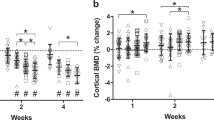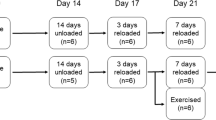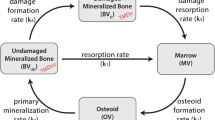Abstract
The removal of regular weight-bearing activity generates a skeletal adaptive response in both humans and animals, resulting in a loss of bone mineral. Human models of disuse osteoporosis, namely bed rest, spinal cord injury and exposure to micro-gravity demonstrate the negative calcium balance, alterations in biochemical markers of bone turnover and resultant loss of bone mineral in the lower limbs that occurs with reduced weight-bearing loading. The site-specific nature of the bone response is consistent in all models of disuse; however, the magnitude of the skeletal adaptive response may differ across models. It is important to understand the various manifestations of disuse osteoporosis, particularly when extrapolating knowledge gained from research using one model and applying it to another. In rats, hindlimb unloading and exposure to micro-gravity also result in a significant bone response. Bone mineral is lost, and changes in calcium metabolism and biochemical markers of bone turnover similar to humans are noted. Restoration of bone mineral that has been lost because of a period of reduced weight bearing may be restored upon return to normal activity; however, the recovery may not be complete and/or may take longer than the time course of the original bone loss. Fluid shear stress and altered cytokine activity may be mechanistic features of disuse osteoporosis. Current literature for the most common human and animal models of disuse osteoporosis has been reviewed, and the bone responses across models compared.






Similar content being viewed by others
References
Whedon GD, Heaney RP. Effects of physical activity, paralysis and weightlessness on bone growth. In: Hall BK, editor. Bone. Boca Raton (FL): CRC Press Inc., 1993: 57–77
Holick MF. Perspective on the impact of weightlessness on calcium and bone metabolism. Bone 1998; 22 (5 Suppl.): 105S-11S
Collet P, Uebelhart D, Vico L, et al. Effects of 1- and 6-month spaceflight on bone mass and biochemistry in two humans. Bone 1997; 20 (6): 547–51
Vico L, Collet P, Guignandon A, et al. Effects of long-term microgravity exposure on cancellous and cortical weight-bearing bones of cosmonauts. Lancet 2000; 355 (9215): 1607–11
Bikle DD, Halloran BP. The response of bone to unloading. J Bone Miner Metab 1999; 17 (4): 233–44
Garland DE, Stewart CA, Adkins RH, et al. Osteoporosis after spinal cord injury. J Orthop Res 1992; 10: 371–8
Szollar SM, Martin EM, Sartoris DJ, et al. Bone mineral density and indexes of bone metabolism in spinal cord injury. Am J Phys Med Rehabil 1998; 77 (1): 28–35
Kiratli BJ, Smith AE, Nauenberg T, et al. Bone mineral and geometric changes through the femur with immobilization due to spinal cord injury. J Rehabil Res Dev 2000; 37 (2): 225–33
Lazo MG, Shirazi P, Sam M, et al. Osteoporosis and risk of fracture in men with spinal cord injury. Spinal Cord 2001; 39 (4): 208–14
Frey-Rindova P, de Bruin ED, Stussi E, et al. Bone mineral density in upper and lower extremities during 12 months after spinal cord injury measured by peripheral quantitative computed tomography. Spinal Cord 2000; 38 (1): 26–32
Vico L, Chappard D, Alexandre C, et al. Effects of a 120 day period of bed-rest on bone mass and bone cell activities in man: attempts at countermeasure. Bone Miner 1987; 2 (5): 383–94
Zerwekh JE, Ruml LA, Gottschalk F, et al. The effects of twelve weeks of bed rest on bone histology, biochemical markers of bone turnover, and calcium homeostasis in eleven normal subjects. J Bone Miner Res 1998; 13 (10): 1594–601
Uebelhart D, Bernard J, Hartmann DJ, et al. Modifications of bone and connective tissue after orthostatic bedrest. Osteoporos Int 2000; 11 (1): 59–67
LeBlanc A, Schneider V, Krebs J, et al. Spinal bone mineral after 5 weeks of bed rest. Calcif Tissue Int 1987; 41 (5): 259–61
Leblanc AD, Schneider VS, Evans HJ, et al. Bone mineral loss and recovery after 17 weeks of bed rest. J Bone Miner Res 1990; 5 (8): 843–50
Biering-Sorensen F, Bohr HH, Schaadt OP. Longitudinal study of bone mineral content in the lumbar spine, the forearm and the lower extremities after spinal cord injury. Eur J Clin Invest 1990; 20: 330–5
Wilmet E, Ismail AA, Heilporn A, et al. Longitudinal study of the bone mineral content and of soft tissue composition after spinal cord section. Paraplegia 1995; 33 (11): 674–7
de Bruin ED, Dietz V, Dambacher MA, et al. Longitudinal changes in bone in men with spinal cord injury. Clin Rehabil 2000; 14 (2): 145–52
Palle S, Vico L, Bourrin S, et al. Bone tissue response to four month antiorthostatic bedrest: a bone histomorphometric study. Calcif Tissue Int 1992; 51 (3): 189–94
Goodship AE, Cunningham JL, Oganov V, et al. Bone loss during long term space flight is prevented by the application of a short term impulsive mechanical stimulus. Acta Astronaut 1998; 43 (3–6): 65–75
Grigoriev AI, Morukov BV, Oganov VS, et al. Effect of exercise and bisphosphonate on mineral balance and bone density during 360 day antiorthostatic hypokinesia. J Bone Miner Res 1992; 7 Suppl. 2: S449–55
Goemaere S, Van Laere M, De Neve P, et al. Bone mineral status in paraplegic patients who do or do not perform standing. Osteoporos Int 1994; 4 (3): 138–43
Kunkel CF, Scremin AM, Eisenberg B, et al. Effect of ’standing’ on spasticity, contracture, and osteoporosis in paralyzed males. Arch Phys Med Rehabil 1993; 74 (1): 73–8
Needham-Shropshire BM, Broton JG, Klose J, et al. Evaluation of a training program for persons with SCI paraplegia using the Parastep 1 Ambulation System. Part 3: lack of effect on bone mineral density. Arch Phys Med Rehabil 1997; 78: 799–803
BeDell KK, Scremin AM, Perell KL, et al. Effects of functional electrical stimulation-induced lower extremity cycling on bone density of spinal cord-injured patients. Am J Phys Med Rehabil 1996; 75 (1): 29–34
Belanger M, Stein RB, Wheeler GD, et al. Electrical stimulation: can it increase muscle strength and reverse osteopenia in spinal cord injured individuals? Arch Phys Med Rehabil 2000; 81 (8): 1090–8
Bloomfield SA, Mysiw WJ, Jackson RD. Bone mass and endocrine adaptations to training in spinal cord injured individuals. Bone 1996; 19 (1): 61–8
Hangartner TN, Rodgers MM, Glaser RM, et al. Tibial bone density loss in spinal cord injured patients: effects of FES exercise. J Rehabil Res Dev 1994; 31 (1): 50–61
Leeds EM, Klose KJ, Ganz W, et al. Bone mineral density after bicycle ergometry training. Arch Phys Med Rehabil 1990; 71 (3): 207–9
Mohr T, Podenphant J, Biering-Sorensen F, et al. Increased bone mineral density after prolonged electrically induced cycle training of paralyzed limbs in spinal cord injured man. Calcif Tissue Int 1997; 61 (1): 22–5
Caillot-Augusseau A, Lafage-Proust MH, Soler C, et al. Bone formation and resorption biological markers in cosmonauts during and after a 180-day space flight (Euromir 95). Clin Chem 1998; 44 (3): 578–85
Caillot-Augusseau A, Vico L, Heer M, et al. Space flight is associated with rapid decreases of undercarboxylated osteocalcin and increases of markers of bone resorption without changes in their circadian variation: observations in two cosmonauts. Clin Chem 2000; 46 (8 Pt 1): 1136–43
Smith SM, Wastney ME, Morukov BV, et al. Calcium metabolism before, during, and after a 3-mo spaceflight: kinetic and biochemical changes. Am J Physiol 1999; 277 (1 Pt 2): R1–10
LeBlanc A, Schneider V, Spector E, et al. Calcium absorption, endogenous excretion, and endocrine changes during and after long-term bed rest. Bone 1995; 16 (4 Suppl.): 301S-4S
Lueken SA, Arnaud SB, Taylor AK, et al. Changes in markers of bone formation and resorption in a bed rest model of weightlessness. J Bone Miner Res 1993; 8 (12): 1433–8
Pietschmann P, Pils P, Woloszczuk W, et al. Increased serum osteocalcin levels in patients with paraplegia. Paraplegia 1992; 30: 204–9
Uebelhart D, Hartmann D, Vuagnat H, et al. Early modifications of biochemical markers of bone metabolism in spinal cord injury patients: a preliminary study. Scand J Rehabil Med 1994; 26: 197–202
Uebelhart D, Demiaux-Domenech B, Roth M, et al. Bone metabolism in spinal cord injured individuals and in others who have prolonged immobilisation: a review. Paraplegia 1995; 33 (11): 669–73
Roberts D, Lee W, Cuneo RC, et al. Longitudinal study of bone turnover after acute spinal cord injury. J Clin Endocrinol 1998; 83: 415–22
Smith SM, Nillen JL, Leblanc A, et al. Collagen cross-link excretion during space flight and bed rest. J Clin Endocrinol Metab 1998; 83 (10): 3584–91
Minaire P, Neunier P, Edouard C, et al. Quantitative histological data on disuse osteoporosis: comparison with biological data. Calcif Tissue Res 1974; 17 (1): 57–73
Finsen V, Indredavik B, Fougner KJ. Bone mineral and hormone status in paraplegics. Paraplegia 1992; 30 (5): 343–7
Morey-Holton ER, Globus RK. Hindlimb unloading of growing rats: a model for predicting skeletal changes during space flight. Bone 1998; 22 (5): 83S-8S
Lafage-Proust MH, Collet P, Dubost JM, et al. Space-related bone mineral redistribution and lack of bone mass recovery after reambulation in young rats. Am J Physiol 1998; 274 (2 Pt 2): R324–34
Vico L, Novikov VE, Very JM, et al. Bone histomorphometric comparison of rat tibial metaphysis after 7-day tail suspension vs 7-day spaceflight. Aviat Space Environ Med 1991; 62 (1): 26–31
Westerlind KC, Turner RT. The skeletal effects of spaceflight in growing rats: tissue-specific alterations in mRNA levels for TGF-beta. J Bone Miner Res 1995; 10 (6): 843–8
Turner RT, Evans GL, Wakley GK. Spaceflight results in depressed cancellous bone formation in rat humeri. Aviat Space Environ Med 1995; 66 (8): 770–4
Inman CL, Warren GL, Hogan HA, et al. Mechanical loading attenuates bone loss due to immobilization and calcium deficiency. J Appl Physiol 1999 Jul; 87 (1): 189–95
Dehority W, Halloran BP, Bikle DD, et al. Bone and hormonal changes induced by skeletal unloading in the mature male rat. Am J Physiol 1999; 276 (1 Pt 1): E62–9
Colleran PN, Wilkerson MK, Bloomfield SA, et al. Alterations in skeletal perfusion with simulated microgravity: a possible mechanism for bone remodeling. J Appl Physiol 2000; 89 (3): 1046–54
Halloran BP, Bikle DD, Harris J, et al. Skeletal unloading decreases production of 1,25-dihydroxyvitamin D. Am J Physiol 1993 May; 264 (5 Pt 1): E712–6
Bourrin S, Palle S, Genty C, et al. Physical exercise during remobilization restores a normal bone trabecular network after tail suspension-induced osteopenia in young rats. J Bone Miner Res 1995 May; 10 (5): 820–8
Sessions ND, Halloran BP, Bikle DD, et al. Bone response to normal weight bearing after a period of skeletal unloading. Am J Physiol 1989; 257 (4 Pt 1): E606–10
Matsumoto T, Nakayama K, Kodama Y, et al. Effect of mechanical unloading and reloading on periosteal bone formation and gene expression in tail-suspended rapidly growing rats. Bone 1998; 22 (5 Suppl.): 89S-93S
Bikle DD, Harris J, Halloran BP, et al. Altered skeletal pattern of gene expression in response to spaceflight and hindlimb elevation. Am J Physiol 1994; 267 (6 Pt 1): E822–7
Drissi H, Lomri A, Lasmoles F, et al. Skeletal unloading induces biphasic changes in insulin-like growth factor-I mRNAlevels and osteoblast activity. Exp Cell Res 1999; 251 (2): 275–84
Kaneps AJ, Stover SM, Lane NE. Changes in canine cortical and cancellous bone mechanical properties following immobilization and remobilization with exercise. Bone 1997; 21 (5): 419–23
Young DR, Niklowitz WJ, Steele CR. Tibial changes in experimental disuse osteoporosis in the monkey. Calcif Tissue Int 1983; 35 (3): 304–8
Young DR, Niklowitz WJ, Brown RJ, et al. Immobilization associated osteoporosis in primates. Bone 1986; 7 (2): 109–17
Skerry TM, Lanyon LE. Interruption of disuse by short duration walking exercise does not prevent bone loss in the sheep calcaneus. Bone 1995; 16 (2): 269–74
Chow YW, Inman C, Pollintine P, et al. Ultrasound bone densitometry and dual energy X-ray absorptiometry in patients with spinal cord injury: a cross-sectional study. Spinal Cord 1996; 34 (12): 736–41
Rubin C, Xu G, Judex S. The anabolic activity of bone tissue, suppressed by disuse, is normalized by brief exposure to extremely low-magnitude mechanical stimuli. FASEB J 2001; 15 (12): 2225–9
Frost HM. Bone ’mass’ and the ’mechanostat’: a proposal. Anat Rec 1987; 219 (1): 1–9
Castro MJ, Apple Jr DF, Hillegass EA, et al. Influence of complete spinal cord injury on skeletal muscle cross-sectional area within the first 6 months of injury. Eur J Appl Physiol Occup Physiol 1999; 80 (4): 373–8
Baldwin KM. Effect of spaceflight on the functional, biochemical, and metabolic properties of skeletal muscle. Med Sci Sports Exerc 1996; 28 (8): 983–7
Vico L, Lafage-Proust MH, Alexandre C. Effects of gravitational changes on the bone system in vitro and in vivo. Bone 1998; 22 (5 Suppl.): 95S-100S
Bergula AP, Huang W, Frangos JA. Femoral vein ligation increases bone mass in the hindlimb suspended rat. Bone 1999; 24 (3): 171–7
Kostenuik PJ, Harris J, Halloran BP, et al. Skeletal unloading causes resistance of osteoprogenitor cells to parathyroid hormone and to insulin-like growth factor-I. J Bone Miner Res 1999; 14 (1): 21–31
Smalt R, Mitchell FT, Howard RL, et al. Induction of NO and prostaglandin E2 in osteoblasts by wall-shear stress but not mechanical strain. Am J Physiol 1997; 273 (4 Pt 1): E751–8
Owan I, Burr DB, Turner CH, et al. Mechanotransduction in bone: osteoblasts are more responsive to fluid forces than mechanical strain. Am J Physiol 1997; 273 (3 Pt 1): C810–5
Acknowledgements
Funding was provided by the Ontario Neurotrauma Foundation. The results and conclusions are those of the authors. The authors have no conflicts of interest relevant to the contents of this manuscript.
Author information
Authors and Affiliations
Rights and permissions
About this article
Cite this article
Giangregorio, L., Blimkie, C.J.R. Skeletal Adaptations to Alterations in Weight-Bearing Activity. Sports Med 32, 459–476 (2002). https://doi.org/10.2165/00007256-200232070-00005
Published:
Issue Date:
DOI: https://doi.org/10.2165/00007256-200232070-00005




